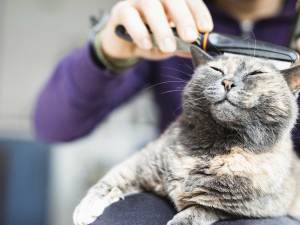Most dogs and cats will pick up fleas at least once in their lifetime. Even pets that never go outdoors are at risk from fleas that can find their way into your home.
It’s important to catch and stop fleas early before they multiply inside your home and become an even bigger problem. That’s why regularly checking for fleas should be part of your routine pet care.
Always keep an eye out
Adult fleas can sometimes be easy to spot, particularly in short and light-colored fur. The underside of your pet usually has less hair, which makes it even easier to spot those pesky fleas. Fleas are more difficult to find in dark-haired pets. Pets may groom the fleas out before you have a chance to see them. Even though you don’t see fleas, your pet may still have them.1
Try parting the coat near the base of the tail using your hands or a flea comb and look for movement. Most fleas grow to about the size of a pinhead and will move or jump when disturbed.1
Most dogs and cats will chew their hair over their tailhead region if fleas are present. Look for areas with shorter or missing hair.1
Signs of fleas
Even if you don’t see any fleas, have a look for dark, pepper-like particles on the surface of your pet’s skin and coat. These may be flea droppings, known as “flea dirt.”
You can easily confirm the presence of flea dirt by dabbing some of this material with a wet paper towel or cotton ball. If you see dark reddish brown or orange swirls, this may be flea dirt and could mean that your pet has fleas.1 You need to take action now and contact your veterinarian!
Prevention
Protect your pets from flea and tick infestations with BRAVECTO® (fluralaner), a leading treatment for dogs and cats. Bravecto provides long-lasting defense with options like BRAVECTO® (fluralaner) Chews or BRAVECTO® (fluralaner topical solution). It quickly eliminates fleas and ticks for up to 12 weeks of continuous protection.* Keep your pets safe and worry-free with Bravecto.2
References:
1. Dryden Michael W. Flea Allergy Dermatitis in Dogs and Cats. Merck Manual Veterinary Manual. https://www.merckvetmanual.com/integumentary-system/fleas-and-flea-allergy-dermatitis/flea-allergy-dermatitis-in-dogs-and-cats
2. Bravecto®. https://merckusa.cvpservice.com/product/basic/view/1047512
*BRAVECTO kills fleas, prevents flea infestations. BRAVECTO (fluralaner) Chews for Dogs kills ticks (black-legged tick, American dog tick, brown dog tick, and Asian longhorned tick) for 12 weeks. BRAVECTO Chews also kills lone star ticks for 8 weeks. BRAVECTO (fluralaner topical solution) for Dogs kills ticks (black-legged tick, American dog tick, and brown dog tick) for 12 weeks. BRAVECTO Topical Solution for Dogs also kills lone star ticks for 8 weeks. BRAVECTO (fluralaner topical solution) for Cats kills ticks (black-legged tick and Asian longhorned tick) for 12 weeks. BRAVECTO Topical Solution for Cats also kills American dog ticks for 8 weeks.
Important Safety Information:
BRAVECTO 1-MONTH (fluralaner) Chews: indicated for dogs 8 weeks of age and older. The most commonly reported adverse reactions include itching, diarrhea, vomiting, decreased appetite, elevated ALT, lethargy, and weight loss. BRAVECTO 1-MONTH (fluralaner) Chews is not effective against A. americanum in puppies less than 6 months of age. BRAVECTO (fluralaner) Chews: The most commonly reported adverse reactions include vomiting, lethargy, diarrhea, anorexia and pruritus. In some cases, adverse events have been reported following use in breeding females. BRAVECTO (fluralaner topical solution) for Dogs: The most commonly reported adverse reactions include vomiting, hair loss, diarrhea, lethargy, decreased appetite, and moist dermatitis/rash. BRAVECTO (fluralaner topical solution) for Cats: The most commonly reported adverse reactions include vomiting, itching, diarrhea, hair loss, decreased appetite, lethargy, and scabs/ulcerated lesions. BRAVECTO (fluralaner topical solution) for Cats is not effective against American dog ticks beyond 8 weeks of dosing. BRAVECTO PLUS (fluralaner and moxidectin topical solution) for Cats: The most commonly reported adverse reactions include vomiting, hair loss, itching, diarrhea, lethargy, dry skin, elevated ALT, and hypersalivation. BRAVECTO PLUS (fluralaner and moxidectin topical solution) has not been shown to be effective for 2 months in kittens less than 6 months of age. Use with caution in cats that are heartworm positive. The effectiveness of BRAVECTO PLUS (fluralaner and moxidectin topical solution) to prevent heartworm disease after bathing or water immersion has not been evaluated.
BRAVECTO (fluralaner) has not been shown to be effective for 12-weeks’ duration in puppies or kittens less than 6 months of age. BRAVECTO (fluralaner) Chews and Topical Solution for dogs is not effective against the lone star tick beyond 8 weeks of dosing. BRAVECTO (fluralaner topical solution) for Dogs and Cats and BRAVECTO PLUS (fluralaner and moxidectin topical solution) for cats are for topical use only. Avoid oral ingestion. The safety of BRAVECTO (fluralaner topical solution) for Cats and BRAVECTO PLUS (fluralaner and moxidectin topical solution) has not been established in breeding, pregnant, and lactating cats.
All BRAVECTO (fluralaner) products contain fluralaner, which is a member of the isoxazoline class. This class has been associated with neurologic adverse reactions including tremors, ataxia, and seizures. Seizures have been reported in dogs receiving isoxazoline class drugs, even in dogs without a history of seizures. Use with caution in dogs with a history of seizures or neurologic disorders. Neurologic adverse reactions have been reported in cats receiving isoxazoline class drugs, even in cats without a history of neurologic disorders. Use with caution in cats with a history of neurologic disorders.
Want to share this article?
More like this
September is dog tick season
The weather is beautiful, fall is just around the corner … and it’s peak season for ticks.
Tick talk
Use our tick identifier to select a tick and learn about what it looks like, where it lives, and what risks it might pose to your pet.
Caring for a senior pet
Cats and dogs may need special attention as they age, so it helps to understand what to expect as your pet gets older.





